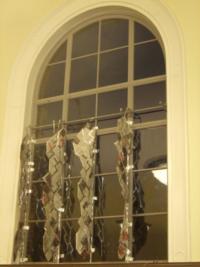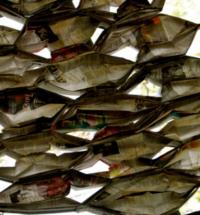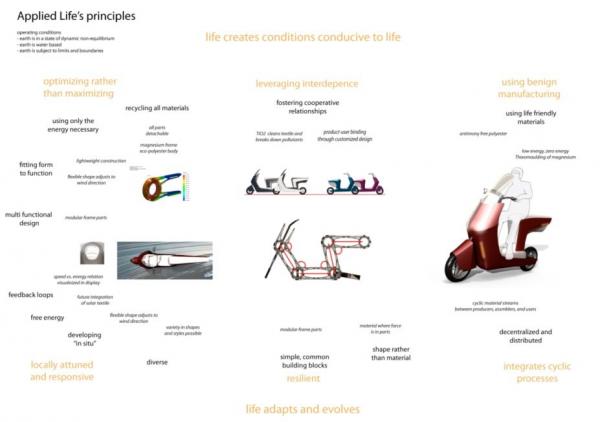Biomimicry in Higher Education Webinar (Karen Verbeek)
 This past January, the Biomimicry Institute hosted the webinar “Biomimicry in Higher Education”. The full proceedings, including abstracts of two of the teaching modules, can be purchased from the Biomimicry Institute ($10, 79 page PDF). The event was extremely informative, inspiring and useful for understanding where biomimicry is being integrated into higher learning today. The experiences from a diverse range of educators highlighted some of the challenges they face in bringing biomimicry into the existing curricula but also showed how productive these efforts can be. Imagine what this might be like in another five years!
This past January, the Biomimicry Institute hosted the webinar “Biomimicry in Higher Education”. The full proceedings, including abstracts of two of the teaching modules, can be purchased from the Biomimicry Institute ($10, 79 page PDF). The event was extremely informative, inspiring and useful for understanding where biomimicry is being integrated into higher learning today. The experiences from a diverse range of educators highlighted some of the challenges they face in bringing biomimicry into the existing curricula but also showed how productive these efforts can be. Imagine what this might be like in another five years!
Over the course of three hours, an enormous amount of information and inspiration was shared that can be applied beyond the classroom experience. The topics were wide ranging, highlighting the impact of biomimicry education into existing science, engineering and design programs (see table below). The design discipline presentations included project work in the fields of environmental remediation, interior design, architecture, and industrial design. Full teaching modules of Dr. Dona Boggs' Much ado about CO2 as well as Adrian Smith’s Biology into Design Module; Self-Organization and Group Behavior are available in the University Curricula section of the Biomimicry Institute website.
Biomimicry in Higher Education Overview
(adapted from http://www.biomimicryinstitute.org/education/university/biomimicry-in-higher-education-webinar.html)
| Topic | Presenter |
| Integrating Biomimicry in Programs | |
| Functional Biology in Multidisciplinary Bioscience Courses | Dr. Janet Kübler, PhD, California State University, Northridge |
| Teaching Biomimicry in the Context of Engineering Design | Dr. Jacquelyn Nagel, PhD |
| A PhD in Biomimicry: How Would Nature Do That? | Dr. Peter Niewiarowski, PhD, University of Akron, and Douglas Paige, BFA, The Cleveland Institute of Art |
| Education Modules | |
| Free Energy | |
| Surfing for Free: Optimizing Thermodynamic Pathways for Innovative Solutions | Tom McKeag, California College of the Arts |
| Swarm Logic | |
| Biology into Design Module; Self-Organization and Group Behaviour | Adrian Smith, PhD candidate, Arizona State University, Tempe |
| Carbon cycle | |
| Much ado about CO2 : Education Module by Dr. Dona Boggs | Curt McNamara presenting on behalf of Dona Boggs, Professor Emeritus, Eastern Washington University |
| Applying Biomimicry to Projects: Design Practice | |
| Environmental Remediation | |
| Teaching and learning with nature by using biomimicry approach to restore three keystone coastal habitats | Dr. Anamarija Frankic, PhD, University of Massachusetts, Boston |
| Interior Design | |
| Using Biology to Guide Design | Karen Sullivan, Adjunct, Miami University |
| Architecture | |
| Biomimetic Envelopes Investigating nature to Design Buildings | Ilaria Mazzoleni, Southern California Institute of Architecture |
| Biomimicry: Towards a Sustain-Able Design | Catalina Freixas, Senior Lecturer in Architecture, Sam Fox School of Design & Visual Arts, Washington University in St. Louis |
| Biomimicry Methodologies and Tools | |
| Industrial Design and Manufacturing | |
| Bio-Inspired Design of an Electric Scooter Body | Ernst-Jan Mul, MSc, Bio-Inspired Design |
| Concept Transfer from Biological Junctions to End-of-Life Disassembly in Industrial Design | Dr. Carlo Santulli, Sapienza Università di Roma, and Carla Langella, Seconda Università di Napoli |
Two of the papers (highlighted in blue) are summarized below. The papers highlighted in green will be included in the September issue of this newsletter.
Interior Design: Using Biology to Guide Design (Karen Sullivan, Adjunct, Miami University)
Biomimicry was introduced as a tool to guide the design process in a student-driven charrette. Nature provides us with abundant solar energy yet controlling it within buildings can be problematic.
The students decided on a design challenge that would address an existing situation using sustainable design principles. The students used reclaimed and recycled materials to create shading devices that would improve both the quality of natural daylight and the thermal conditions in the studio that included fluctuating light levels, glare and heat gain/loss. The students addressed:
- The factors contributing to good quality daylighting,
- Energy savings due to heating and cooling loads from artificial light,
- The local context of solar characteristics and their effects on materials.
Life’s Principles were used to develop their design solutions, specifically:
- Self-organizing,
- Building from the bottom up,
- Cultivating cooperative relationships,
- Simple common building blocks,
- Multi-functional design,
- Fitting form to function,
- Use of free energy and cyclic processes.
 Vegetation such as trees and sunflowers provided examples of natural models that perform many of
Vegetation such as trees and sunflowers provided examples of natural models that perform many of  the functions needed in this design solution. Insects such as butterflies provided thermal regulation models. Consistent with the sustainability goals of the charrette, the students chose newspaper and one additional material as their building materials. The biomimicry approach was useful as an interdisciplinary tool and for developing a range of design solutions. Its influence is apparent in the final designs, two of which are shown below. The design by Team A (on the left) "allowed for varying degrees of openness and was inspired by butterfly wings". The design by Team C (on the right) "was an elegant solution inspired by cell structures that had the ability to open and close similar to an eyelid."
the functions needed in this design solution. Insects such as butterflies provided thermal regulation models. Consistent with the sustainability goals of the charrette, the students chose newspaper and one additional material as their building materials. The biomimicry approach was useful as an interdisciplinary tool and for developing a range of design solutions. Its influence is apparent in the final designs, two of which are shown below. The design by Team A (on the left) "allowed for varying degrees of openness and was inspired by butterfly wings". The design by Team C (on the right) "was an elegant solution inspired by cell structures that had the ability to open and close similar to an eyelid."
Industrial Design and Manufacturing: Bio-Inspired Design of an Electric Scooter Body (Ernst-Jan Mul, MSc, Bio-Inspired Design)
Ernst-Jan Mul used biomimicry to design an electric scooter body (called the "Fit") using Life’s Principles to generate and evaluate sustainable designs. He developed the environment scan and connection diagram tools to assist in the biomimetic process.
“The project aimed to answer two main questions:
- How can biomimicry be applied to a product development process?
- What influence does applying biomimicry have on the design of a product?” (p. 46)
Several organisms and natural principles inspired the Scooter Body design. Mul specifically referred to the skeletal connections of the ribcage and spine, bending of leaves in the wind, genetic plasticity and the hydrodynamic shape of the dolphin as sources of inspiration. Life’s Principles were directly related to features of the scooter body design to support sustainability goals and provide a more responsive design.
The project and tools show how to introduce biomimicry into the product development process. Life’s Principles were also highlighted as a way to evaluate the sustainability of the design solutions.
“Industrial design engineers add most value in a product development process by selecting a right combination of desired forms and functionalities, materialized by existing technologies and manufacturing processes. Therefore, the largest gains in the sustainability of a product-system can be won by creating a combination of these elements that renders the product locally attuned and makes it leverage its interdependence.” (p. 55)
Finally, Mul emphasizes the importance of tool development and cooperation with specialists in fields such as ecology, computing and systems engineering in establishing a solid foundation for the application of biomimicry as a strategy for sustainable design.
Webinar Summary
The webinar provided a wealth of information regarding the application of Life’s Principles and organism study to design processes. In addition, the presentations on other topics more directly related to interdisciplinary education offer valuable insights into collaborative, interdisciplinary work strategies. The presentations on education strategies and the education modules have information applicable to education in general and can be tailored for any level even though they are intended for the post-secondary audience.
The challenges of introducing a topic such as biomimicry into a traditional discipline were also mentioned by various presenters. Readers will find these challenges to be familiar - they are the same ones we often face when initially introducing biomimicry or incorporating it into an existing setting, system, culture or process. Each presentation provided insights on how to introduce biomimicry, develop tools to integrate it and selecting projects to highlight the sustainable biomimetic approach to problem solving.
Additional Readings:
- Connection-Based Tools for Bio-Inspired Design (additional details of Mul's environment scan and connection diagram tools)
- An Interview with a Bio-Inspired Designer (Ernst-Jan Mul)
Image Credits:
- Networked world: © ktsdesign - Fotolia.com
- vertical shading inspired by butterfly wings: Karen Sullivan
- dynamic shading inspired by cells: Stephen Young
- "Fit" scooter inspiration: Ernst-Jan Mul

Karen Verbeek has a biology and industrial design background and attended the Costa Rica Biomimicry Workshop. She is currently focusing on education in the Greater Toronto Area and building a biomimicry network.

